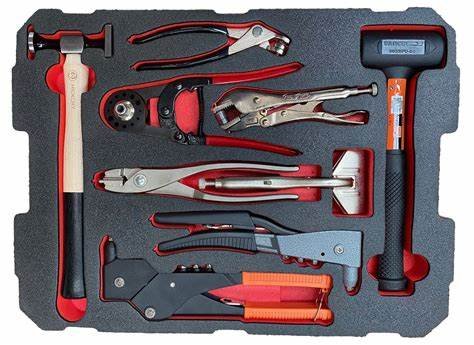In the ever-evolving field of aeronautical engineering, precision and efficiency are not optional—they are mandatory. Engineers working on complex aircraft systems, propulsion technologies, and structural designs require specialized tools to maintain accuracy, ensure safety, and enhance productivity. Whether you are involved in research, design, testing, or maintenance, having the right tools is crucial for meeting the rigorous standards of the aerospace industry. For professionals in the EPCI (Engineering, Procurement, Construction, and Installation) sector, the right set of aeronautical tools is essential to deliver projects that adhere to global aviation standards while optimizing workflows.
One of the most indispensable tools in aeronautical engineering is Computer-Aided Design (CAD) software. This software allows engineers to create and analyze complex 3D models of aircraft components with exceptional accuracy. CAD software not only facilitates detailed design and prototyping but also enables engineers to conduct stress analysis and aerodynamic simulations. This advanced modeling capability helps in identifying potential structural weaknesses, optimizing designs for performance, and reducing the need for physical prototypes. For large-scale aerospace projects, CAD software serves as the foundation for collaborative design efforts, allowing multiple teams to work seamlessly on integrated systems.
Precision measuring instruments are equally vital in aeronautical engineering. Tools such as digital calipers, micrometers, and coordinate measuring machines (CMM) provide the exact measurements needed for assembling and inspecting aircraft parts. Given the tight tolerances required in aerospace manufacturing, even minor deviations can lead to system failures or safety hazards. Digital calipers and micrometers allow for precise dimensional measurements, while CMMs provide detailed geometric assessments of complex components. These tools ensure that every part meets stringent industry standards, minimizing errors and enhancing the reliability of aerospace systems.
Material testing equipment plays a critical role in ensuring the durability and performance of aircraft materials. Aeronautical engineers work with advanced composites, titanium alloys, and other high-performance materials that must withstand extreme environmental conditions. Tools like tensile testing machines, hardness testers, and fatigue testing systems help engineers evaluate material properties such as strength, elasticity, and resistance to wear. Accurate material testing ensures that aircraft components perform reliably under operational stress, meeting regulatory requirements and enhancing passenger safety. Without these testing tools, engineers would be unable to verify the integrity of critical aerospace structures.
Aerodynamic analysis tools are indispensable for optimizing aircraft performance. Wind tunnels, computational fluid dynamics (CFD) software, and pressure measurement systems allow engineers to study airflow patterns, lift generation, and drag reduction. Wind tunnel testing provides empirical data on how air flows around aircraft surfaces, helping to refine designs for improved efficiency. CFD software complements physical testing by simulating airflow digitally, allowing engineers to visualize pressure distribution and thermal effects. These tools are essential for designing fuel-efficient aircraft, reducing noise emissions, and ensuring compliance with environmental standards.
In aeronautical engineering, accurate assembly and maintenance require specialized hand and power tools. Torque wrenches, rivet guns, and safety wire pliers are among the most frequently used tools for assembling and securing critical components. Torque wrenches ensure that fasteners are tightened to precise specifications, preventing mechanical failure due to under- or over-tightening. Rivet guns are essential for fastening aircraft skins and structural parts, while safety wire pliers are used to secure fasteners in high-vibration environments. These tools provide the mechanical reliability needed to maintain the structural integrity and operational safety of aircraft.
Diagnostic and inspection tools are vital for ensuring the continued airworthiness of aircraft. Non-destructive testing (NDT) equipment, such as ultrasonic testers, radiographic imaging systems, and borescopes, allows engineers to inspect internal structures without disassembling critical components. Ultrasonic testing detects internal flaws like cracks and voids, while radiographic imaging provides detailed X-ray views of hidden areas. Borescopes offer visual inspections of engine interiors and other hard-to-reach spaces. These tools play a key role in preventive maintenance, allowing engineers to identify potential failures before they become operational risks.
Software tools for data analysis and project management are also essential for aeronautical engineering projects. Engineers rely on specialized software to analyze flight data, model structural behavior, and manage project timelines. Tools like finite element analysis (FEA) software simulate how aircraft components respond to mechanical stresses, helping engineers predict and mitigate structural weaknesses. Project management platforms facilitate collaboration across multidisciplinary teams, ensuring that complex aerospace projects stay on schedule and within budget. These digital solutions enhance decision-making, improve efficiency, and reduce the risk of project delays.
In the highly regulated aerospace industry, compliance with international standards is non-negotiable. Tools designed for quality assurance and regulatory compliance, such as inspection gauges and certification management software, are indispensable. Inspection gauges verify that manufactured components meet dimensional tolerances, while certification management software tracks compliance with aviation authorities like the Federal Aviation Administration (FAA) and the European Union Aviation Safety Agency (EASA). These tools help engineers maintain quality control throughout the production process, ensuring that all systems meet the highest safety and performance standards.
Maintaining precision and efficiency in aeronautical engineering also depends on robust maintenance and calibration practices. Tools must be regularly calibrated to maintain accuracy and reliability over time. Calibration equipment, such as laser alignment systems and master gauges, ensures that measuring instruments remain within acceptable tolerances. Engineers must establish routine maintenance schedules for both mechanical and electronic tools, minimizing the risk of errors and ensuring consistent performance. Proper maintenance not only extends the lifespan of critical tools but also protects the integrity of aerospace projects.
For aeronautical engineers looking to excel in the competitive aerospace industry, investing in advanced tools and staying updated on technological innovations is essential. Access to the latest aeronautical tools enhances efficiency, reduces operational risks, and ensures compliance with industry regulations. As the aerospace sector continues to evolve, the ability to leverage cutting-edge technology and precision tools will define the success of engineering professionals and the safety of modern aircraft.
Elevate your aeronautical engineering capabilities by staying informed and adopting the most advanced tools. Explore expert resources and industry-leading solutions tailored to the aerospace sector. Sign up at epci.ng today and stay ahead in the fast-moving world of aeronautical engineering.
